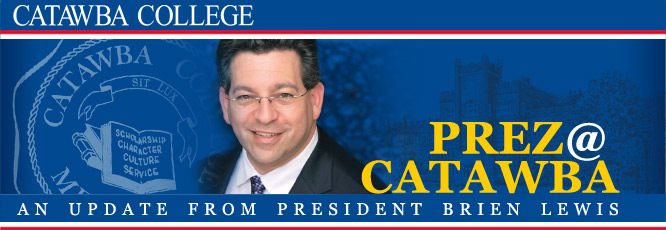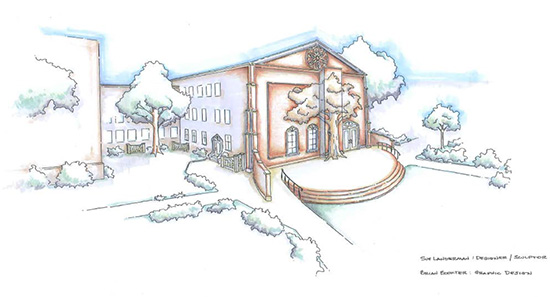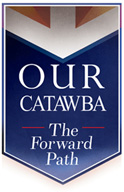
| February 2016 | ||||||
| Dear Friends, I am pleased to provide you with this report on recent activities, progress, and challenges at Catawba College. As always, I want to be as informative and transparent as possible about both the good news and the tough choices we face - while still being concise. If you have any questions, suggestions, or concerns, please do not hesitate to contact me to obtain additional information. |
||||||
Board of Trustees Actions
|
||||||
At their meetings last week the Board of Trustees received a lot of information and engaged in substantive discussions. The following is a brief recap of the highlights:
|
||||||
Congratulations to...
|
||||||
 Dr. Erin Wood Dr. Erin WoodThe Board of Trustees approved the recommendation to confer tenure on Dr. Erin Wood. Please join me in congratulating her on this significant milestone in her academic career! |
||||||
Dr. Douglas Brown, Dr. Beth Homan, Dr. Maria Vandergriff-Avery and Dr. Erin Wood   Please also join me in congratulating Dr. Wood on her promotion to Associate Professor as well as Dr. Brown, Dr. Homan and Dr. Vandergriff-Avery on their promotions to full Professor. These outstanding faculty members have rendered outstanding service to their students and the College and these recognitions are well-deserved. Please also join me in congratulating Dr. Wood on her promotion to Associate Professor as well as Dr. Brown, Dr. Homan and Dr. Vandergriff-Avery on their promotions to full Professor. These outstanding faculty members have rendered outstanding service to their students and the College and these recognitions are well-deserved. |
||||||
Enrollment Updates
|
||||||
| The enrollment team has done a thorough review and analysis to shape our approaches in this recruitment cycle. Preliminary indicators are very encouraging that the new strategies and tactics put in place are having their desired results but it is important we all recognize that it is at a very early stage. As has been our practice, we will budget on level enrollment for the coming year and make plans to utilize additional revenues should they materialize. We are tracking well ahead of where we were on the same date last year in the number of deposited students without any diminution in academic profile. However, it is worth keeping in mind that we were tracking slightly ahead last year at this stage and it is always difficult to ascertain if a crop of students is simply deciding earlier. Major admissions events in the coming weeks will be very important, as will hundreds of individual interactions between faculty, staff, students and our prospective students and their families. Thanks in advance for all you will do to help bring in the strongest possible group of entering students! |
||||||
Strategic Plan and Annual Plan
|
||||||
| Each year's Annual Plan sets forth specific action items which are intended to be accomplished within an academic year in furtherance of longer term goals and objectives. The updated document showing our mid-year progress on each item in the Plan is posted on the website alongside our other key strategic planning documents at: www.catawba.edu/planning. | ||||||
Comprehensive Campaign
|
||||||
|
||||||
"Heart of Campus" - Hedrick Terrace and Stanback Plaza Fountain Projects
|
||||||
 The Board of Trustees had endorsed the concept of a terrace and affixed sculpture for the rear of the Hedrick Administration Building as shared with you in the fall. Unfortunately, the beautiful design that was so well received by the campus community has run into significant structural issues related to the existing underground elements behind the building and the back wall itself. Our hope is to utilize the same design in another project in the future and to bring forward a new plan to accomplish the objective of a signature central gathering space. The Board of Trustees had endorsed the concept of a terrace and affixed sculpture for the rear of the Hedrick Administration Building as shared with you in the fall. Unfortunately, the beautiful design that was so well received by the campus community has run into significant structural issues related to the existing underground elements behind the building and the back wall itself. Our hope is to utilize the same design in another project in the future and to bring forward a new plan to accomplish the objective of a signature central gathering space.Thanks to a generous gift designated for this purpose received last year, this project is already funded. Work should begin on the project once final architectural and engineering plans are completed. As part of the overall effort to enhance the "heart of campus" we will still undertake restoration of the fountain in the center of Stanback Plaza and some other landscaping and visual enhancements. |
||||||
Employee Benefits Task Force
|
||||||
| In order to better communicate and evaluate optimal benefit packages, I asked several faculty and staff members to serve on a Task Force on benefit costs and options. They have undertaken significant research and review of similar colleges and other regional employers with whom we might compete as well as examining "best practices" nationally. I will be holding follow-up conversations with the Task Force and the broader campus community as we seek to identify priorities and funding options for benefits in the 2016-17 fiscal year. I am deeply appreciative of the time and thought put into this work by the dedicated staff and faculty members of the Task Force. Some examples of the suggestions we are already costing out or exploring further include Health Savings Accounts and a "higher deductible" option for health care, as well as a comprehensive new employee orientation and mentoring program. | ||||||
Looking Forwards
|
||||||
| Although there have been some substantial frustrations for all of us over the past several months, I remain deeply committed to and optimistic about Catawba's future. Overall, the College's financial picture has improved in the past few years with significant reductions in both debt and reliance on unrestricted gifts. That said, we still have many of the challenges and pressures faced by so many smaller, tuition-dependent institutions in the higher education landscape today. As reported in the fall, our enrollment overall is not as high as it has been in the past couple of years and, even with some spending reductions in specific areas, and noted improvements in fall-to-spring retention, we will not have a "balanced" budget this fiscal year. Those of you who have attended my campus community presentations have heard me speak to why I believe that we have been in a period of "dynamic equilibrium" - and why I believe we are at an "inflection point". As I have stated, "dynamic equilibrium" is not about standing still, or lack of motion - it is very much about motion. It is where there are forces moving in different directions with the result being you are almost right back where you started - sort of like running up a down escalator! To be clear, we are NOT in any kind of crisis. We are facing headwinds of course - that is the nature of higher education (and of most every type of endeavor you can name today). In order to have aspirations and to ultimately get where we want, we have to FOCUS in the next two years on being MORE of who WE ALREADY ARE. By this I mean we will focus the vast majority of our admissions efforts on North Carolina and our surrounding states. This does not mean we will abandon efforts beyond our borders and environs but instead place more time and resources regionally. In the past 4 years, more than half of new domestic freshmen come from within 50 miles, and yield rates drop significantly the farther from campus one goes. Our main competition is with NC public institutions, not fellow independent colleges. If we can maximize our potential within the state and immediate vicinity, we can improve our financial position most quickly and efficiently. This approach also does not suggest loosening or lowering our academic standards. It simply means connecting with and effectively recruiting more of the same kinds of students we currently serve, and having the best options to meet their educational goals and personal development. Once we are truly in a position of financial strength, we can act on our dreams. Our trajectory therefore would be: 2016 and 2017:
For example, we would need to ensure that the dollars received in enrollment growth far exceed the costs of starting a new (or enhancing an existing) program or activity. The following is, again, purely for illustration:
The other obvious question is what will be done with additional resources generated by this approach if it is successful? The answer there is simple but essential: We will direct new income to academic facilities and programs, and to faculty and staff salaries and benefits. Eventually, having more students to choose from means we can (if we choose to) become more selective and that means better students, higher retention, and higher graduation rates.
|
||||||
A Close Look at Tuition Pricing
|
||||||
| Consonant with - but not directly connected to the EGAP approach outlined above - is the need to take close, hard look at our pricing. For a long time, Catawba has subscribed to the concept of "high tuition and high discounting" - a widely accepted approach among peer institutions across the state and the nation and one I have supported. However, both data and anecdotal evidence are suggesting that the landscape may have begun to shift significantly as prospective students and their families consider their options for higher education and the perceived value and return on investment. This may be especially true in North Carolina, where a strong UNC system offers attractive and affordable options for many residents. We would be doing ourselves and our potential students a disservice if we did not explore very thoroughly and carefully what our pricing structure should be in the future. If we do undertake a price restructuring, we will have to communicate and market the rationales very explicitly (and well in advance) to ensure that the benefits to individuals and the College are fully understood. To be clear, we are not talking about reducing the quality of what we offer or the academic standards required for admission. This is strictly about addressing the often-confusing nature of institutional discounting and attracting students who are turned away by our "sticker price" without an opportunity to learn that Catawba can in fact be a very affordable option. It would also be essential for current students and their families to know that we would not be charging them more than new students. |
||||||
In Conclusion
|
||||||
| As John F. Kennedy said, "There are risks and costs to a program of action, but they are far less than the long range risk and costs of a program of inaction." The steps and considerations outlined in brief above no doubt have their share of risks and costs but if we are to provide for the long-term vitality of the College we must be prepared to undertake a program of action rather than inaction. As always, there are numerous items of note and accomplishments by members of our campus community that are worthy of reporting but that are not included here in the interest of keeping this report as concise as possible. Please check your email and the website regularly to keep up with the latest news, events, and opportunities available on campus. As always, you have my deep appreciation and thanks for all you do for the College. Yours at Catawba, Brien Lewis |
||||||
|
